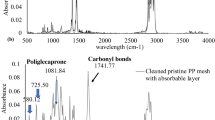Abstract
The use of prostheses for hernia surgery, made from synthetic polymers may lead to development of postoperative complications. The reason for this can be the mismatch of the mechanical properties of meshes and the loads acting on them. The aim of this work was to investigate the behavior of 3 different hernia meshes under in vitro simulated physiological conditions followed by cyclic loadings. Meshes, Ultrapro (poliglecaprone and polypropylene), Dynamesh (polyvinylidenefluoride) and Surgipro (polypropylene) were selected. For in vitro degradation test, samples were kept in alkaline and acid mediums at 37 °C during 42 and 90 days and analyzed in terms of their weight loss and thickness changes. This was followed by cyclic loading in three increasing load stages. The greatest weight loss and thickness reduction were suffered by Ultrapro mesh. The mesh showed pH independent characteristics. Surgipro mesh had pH independent behavior due to the degradation process, with slight weight loss and thickness reduction. The degradation mechanism of Dynamesh is highly dependent on the pH, with acid surrounding medium acting as a degradation catalyst. Mechanical hysteresis was observed in all three meshes. The larger deformations occurred in Surgipro (25%); necking phenomenon was also observed. The deformation of Dynamesh was 22%, the mesh unweaves under applied load and was unable to withstand the third period of cyclic loads. Ultrapro mesh exhibits the lowest level of deformation (10%). Despite the different compositions and architectures of the meshes, all three underwent permanent plastic deformation, which will induce decreased mesh flexibility over time.
Graphical abstract


Similar content being viewed by others
References
Kingsnorth A, LeBlanc K. Hernias: inguinal and incisional. Lancet. 2003;362:1561–1571.
FDA. Medical Devices: Hernia Surgical Mesh Implants. U.S. Department of Health and Human Services. 2016. http://www.fda.gov/MedicalDevices/ProductsandMedicalProcedures/ImplantsandProsthetics/HerniaSurgicalMesh/default.htm. (2016) Accessed 09 Feb 2017.
Agrawal A, Avill R. Mesh migration following repair of inguinal hernia: a case report and review of literature. Hernia . 2006;10:79–82.
Goswarmi R, Babor M, Ojo A. Mesh erosion into caecum following laparoscopic repair of inguinal hernia (TAPP): a case report and literature review. J Laparoendosc Adv Surg Tech A. 2007;17:669–672.
Ozog Y, Konstantinovic M, Werbrouck E, Ridder D, Mazza E, Deprest J. Shrinkage and biomechanical evaluation of lightweight synthetics in a rabbit model for primary fascial repair. Int Urogynecol J. 2011;22:1099–1108.
Cobb WS, Kercher KW, Heniford BT. The argument for lightweight polypropylene mesh in hernia repair. Surg Innov. 2005;12:63–69.
Bringman S, Conze J, Cuccurullo D, Deprest J, Junge K, Klosterhalfen B, Parra-Davila E, Ramshaw B, Schumpelick V. Hernia repair: the search for ideal meshes. Hernia. 2010;14:81–87.
Ethicon. Ethicon US, LLC. 2010–2016. http://www.ethicon.com/healthcare-professionals/products/hernia-repair-and-fixation/hernia-mesh-flat-mesh/ultrapro-partially-absorbable-lightweight-mesh. Accessed 09 Feb 2017.
Textiltechnik. Mesh Implants for Hernia Surgery. ©high standArt, Osnabrück. 2004–2016. http://en.dyna-mesh.com/aplprod/hernia/. Accessed 09 Feb 2017.
Medtronic. Covidien products. Medtronic. 2015. http://products.covidien.com/pages.aspx?page=ProductDetail&id=13374&cat=Devices&cat2=Model. Accessed 09 Feb 2017.
ISO 10993–2011. Estimation of biological activity of medical products. (2011).
Sigma-Aldrich. Phosphate buffered saline-Sigma-Aldrich Co. LLC. http://www.sigmaaldrich.com/catalog/product/sigma/p4417?lang=pt®ion=PT. Accessed 09 Feb 2017.
ISO 13781–2011. Resins and shaped elements poly-L-lactide for surgical implants. Degradation research in vitro. (2011).
Galgut P, Waite I, Smith R. Tissue reaction to biodegradable and non-degradable membranes placed subcutaneously in rats, observed longitudinally over a period of 4 weeks. J Oral Rehabil. 1996;23:17–21.
Sigma-Aldrich. Buffer tablets pH 4.0. Sigma-Aldrich Co. LLC. http://www.sigmaaldrich.com/catalog/product/riedel/36821?lang=pt®ion=PT. Accessed 09 Feb 2017.
Klinge U, Klosterhalfen B, Conze J, Limberg W, Obolenski B, Ottinger AP, Schumpelick V. Modified mesh for hernia repair that is adapted to the physiology of the abdominal wall. Eur J Surg. 1998;164:951–960.
Cobb WS, Burns JM, Kercher KW, Matthews BD, James Norton H, Todd Heniford B. Normal intraabdominal pressure in healthy adults. J Surg Res. 2005;129:231–235.
Cosson M, Debodinance P, Boukerrou M, Chauvet MP, Lobry P, Crépin G, Ego A. Mechanical properties of synthetic implants used in the repair of prolapse and urinary incontinence in women: Which is the ideal material? Int Urogynecol J. 2003;14:169–178.
Röhrnbauer B, Mazza E. Uniaxial and biaxial mechanical characterization of a prosthetic mesh at different length scales. J Mech Behav Biomed Mater. 2014;19:29.
Mazza E, Ehret A. Mechanical biocompatibility of highly deformable biomedical materials. J Mech Behav Biomed Mater. 2015;48:100–124.
Konerding MA, Chantereau P, Delventhal V, Holste JL, Ackermann M. Biomechanical and histological evaluation of abdominal wall compliance with intraperitoneal on1lay mesh implants in rabbits: A comparison of six different state-of-the-art meshes. Med Eng Phys. 2012;34:806–816.
Müller M, Klinge U, Conze J, Schumpelick V. Abdominal wall compliance after Marlex® mesh implantation for incisional hernia repair. Hernia. 1998;2:113–117.
Welty G, Klinge U, Klosterhalfen B, Kasperk R, Schumpelick V. Functional impairment and complaints following incisional hernia repair with different polypropylene meshes. Hernia. 2001;5:142–147.
Sindhwani N, Liaquat Z, Urbankova I, Vande Velde G, Feola A, Deprest J. Immediate postoperative changes in synthetic meshes-In vivo measurements. J Mech Behav Biomed Mater. 2015;55:228–235.
Junge K, Klinge U, Prescher A, Giboni P, Niewiera M, Schumpelick V. Elasticity of the anterior abdominal wall and impact for reparation of incisional hernias using mesh implants. Hernia. 2001;5:113–118.
Acknowledgements
This research has been supported in part by a grant of the EC in the FP7-framework (Bip-Upy; NMP3-LA-2012-310389). The authors gratefully acknowledge funding from: FCT, Portugal, under grants SFRH / BD / 96548 / 2013, SFRH / BPD / 111846 / 2015; UROSPHINX - Project 16842, COMPETE2020, through FEDER and FCT.
Author information
Authors and Affiliations
Corresponding author
Ethics declarations
Conflict of interest
The authors do not have to disclose any financial or personal relationships with other people or organizations that could inappropriately influence (bias) their work.
Rights and permissions
About this article
Cite this article
Rynkevic, R., Martins, P., Pereira, F. et al. In vitro study of the mechanical performance of hernia mesh under cyclic loading. J Mater Sci: Mater Med 28, 176 (2017). https://doi.org/10.1007/s10856-017-5984-6
Received:
Accepted:
Published:
DOI: https://doi.org/10.1007/s10856-017-5984-6




